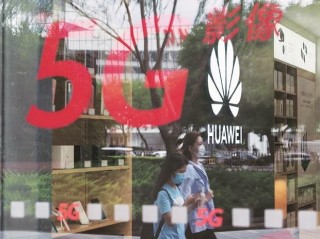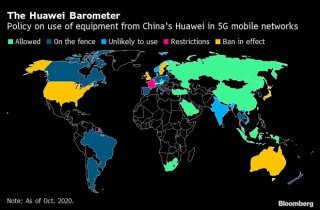Loading
Search
▼ Japan Races To Catch Up To Huawei In 5G Tech After Trump Crackdown On China
- Category:Other
Japanese brands have also fallen behind Nokia Oyj, Ericsson AB and above all Huawei Technologies Co. in the buildout of 5G infrastructure
When Japan invented the world’s first camera-equipped mobile phone two decades ago, it signaled an early but crucial step in the transformation of the phone into a sophisticated high-speed wireless information terminal.
Two decades later, as the world develops 5G networks that are tens of thousands of times faster, the nation that pioneered many of these technologies has been almost entirely absent.
Having lost the lead in consumer-facing handsets after missing the shift to smartphones, Japanese brands have also fallen behind Nokia Oyj, Ericsson AB and above all Huawei Technologies Co. in the buildout of 5G infrastructure.
Those three manufacturers control almost 80% of 5G base-station market share, according to research company TrendForce. But Japanese firms have been handed an unexpected lifeline by the U.S.-led crackdown on Huawei, the Chinese company that was at the forefront of the technology’s rollout.
With U.S. partners seeking out suppliers from friendlier nations, vendors in close U.S. ally Japan suddenly seem a lot more attractive to carriers around the world racing to upgrade their networks.
“It’s given us a chance,” Jun Sawada, chief executive officer of Japan’s telecommunications behemoth Nippon Telegraph & Telephone Corp., also known as NTT, said of the U.S. steps to remove Huawei.
The Huawei Barometer
The 5G opportunity could help the likes of NEC Corp., Fujitsu Ltd. and other network equipment makers make fresh inroads in a global supply chain that’s only set to grow. Recognizing this, the government has also thrown its weight behind the effort, offering hundreds of millions of dollars in support earlier this year to the nation’s few remaining suppliers to build 5G and post-5G technologies.
Since coming to power in September, Prime Minister Yoshihide Suga’s administration has furthered this charge, jumping on the sector as one of its pillars for growth.
“In order to take a global lead in next-generation technology including post-5G and 6G, the government will lead the charge of research and development,” Suga said at a press conference on Friday, announcing more than 1 trillion yen ($9.6 billion) in spending in an upcoming extra budget for technologies including wireless. Having banned installation of Huawei 5G equipment from next September, the U.K. is already soliciting NEC and Fujitsu, as well as South Korea’s Samsung Electronics Co., to assist with its 5G roll-out. NTT in June agreed to acquire a 5% stake in NEC, partnering to jointly develop 5G technologies.
In a report on U.K. supply chains last month, U.K. Digital Secretary Oliver Dowden noted that the decision to remove Huawei would leave the country entirely reliant on just two suppliers, Nokia and Ericsson, to supply critical 5G infrastructure.
“This represents an intolerable resilience risk,” Dowden wrote. The strategy lays out a plan to attract new suppliers and support incumbents so that the nation is “not reliant on any single vendor.”
Shares in NEC have risen about 21% this year, while Fujitsu has added almost 35%, although the gains are largely supported by expectations for their role in Suga’s plans for a digital transformation of Japan’s public sector.
Open Model
Japan’s early attempts to dominate the mobile Internet space failed miserably, with NTT unit NTT Docomo Inc.’s own tightly-controlled I-mode Internet access service unable to catch on in an era of open Internet standards. From Betamax to Blu-Ray, Japanese firms have rarely been associated with promoting open platforms, but are now embracing the concept as they look to cover lost ground amid Huawei’s challenges.
NTT Docomo is one of the founding members of the O-RAN Alliance, a group that is pushing for open radio access networks (RAN) — a crucial part of telecoms infrastructure that connects users’ devices to the broader network.
Traditionally, vendors would supply the RAN and core network together, and as networks became more complex, only the biggest vendors could supply the entire bundle. That advantage accrued for the likes of Nokia, Ericsson and Huawei.
“From the perspective of the carriers, hiring Huawei is easy,” explains Sawada, who spoke to Bloomberg News in an interview earlier this year. “They’ll do everything for you.”
He likened this vertically-integrated approach to that taken by Apple Inc. as compared to Microsoft in PCs or Google in smartphones. The open model aims to break this down and provides opportunities to smaller makers.
“The concept of O-RAN is fine, but Nokia and Ericsson won’t simply stay quiet and stand by,” said Shinji Moriyuki, an analyst at SBI Securities Co. “They may come after the O-RAN alliance with price cuts.”
‘Big Chance’
U.S. President Donald Trump’s administration has campaigned against Huawei’s involvement in 5G networks since 2018, urging its allies to boycott the company’s 5G equipment. Japan has a harder needle to thread than some others, dependent on the U.S. for its national security but also seeking looking to improve relations with its top trading partner. It’s a tension that Sawada acknowledges.
“China and the U.S. are both strong countries,” he said. “The worst thing that could happen for Japan is for them to work together.”
Rakuten Inc., the Japanese e-commerce giant that is building out its mobile phone network in Japan to challenge the long-term incumbents, has embraced O-RAN for its 4G and 5G networks. Founder and CEO Hiroshi Mikitani told a conference in November that he aims to export its network technology overseas and sees its value “easily exceeding 1 trillion yen.”
The open model is also seen bolstering the negotiating position of carriers in contracts for 5G network buildouts, with telcos able to choose from a wide range of suppliers. It also provides opportunities to system integration providers, which Japan’s firms excel at.
“Pursuing this open model which increases competition and seeing how much we can gain is a big challenge for us,” said Takahito Tokita, Fujitsu’s CEO. Earlier this year, Fujitsu sealed a deal to sell 5G technology to Dish Network Corp., which is building out its own network having acquired the Boost wireless business from T-Mobile US Inc.
“This is a multitrillion-dollar market,” he told Bloomberg News. “Even a small percentage of that is a big chance for us,” he said, adding that Fujitsu is still no more than a “newborn chick” compared to the likes of Nokia.
Japan’s firms were once spoken of in western circles in a similar way to China’s are now, working too closely with the central government and benefiting from unfair competitive advantages.
But much has changed in Japanese business since that first camera phone was rolled out — with its maker Sharp Corp. now itself owned by a Taiwanese firm, something almost unthinkable just a decade ago. The 5G era and beyond could show its firms how to fight larger competitors with a more open approach.
- December 11, 2020
- Comment (0)
- Trackback(0)



